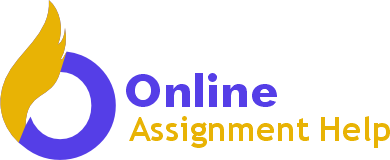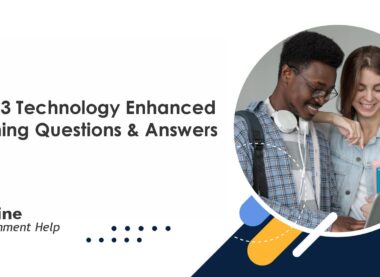Table of Contents
7LD03 Designing Learning to Improve Performance Questions
Question 1 (AC 1.3)
Recognising the importance of showing stakeholders that there are significant benefits to learning interventions and that they can help to improve organisational performance and achieve strategic objectives, develop a business case to propose the investment in two specific learning and development initiatives within your organisation or one with which you are familiar
Question 2 (AC 2.1)
Analyse the external environment of your organisation or one with which you are familiar, identifying two main factors that are/will impact the organisation’s strategy creating future learning needs. Specify the individual and organisational learning needs that are likely to arise from each factor.
Question 3 (AC 3.2)
To achieve more effective evaluation of future learning events, identify the main barriers to the evaluation of learning within organisations. Draw on published research to provide an in-depth discussion about how, as a learning professional, you will plan to overcome these.
Question 4 (AC 4.3)
Critically evaluate one formal and one informal method of delivering learning, recommending when it would be appropriate to use each method
7LD03 Assignment Answers
Question 1 (AC 1.3)
The need for ongoing learning and development in today’s quickly changing corporate environment cannot be overemphasised enough. Organisations that allocate resources towards developing and improving their personnel not only cultivate an environment conducive to innovation but also get a distinct advantage over their competitors. Among several proposals for learning and development initiatives is a Leadership Development Program that our organisation can consider. The purpose of this initiative involves augmenting the leadership skills of our employees, eventually leading to enhanced organisational performance and the attainment of strategic goals.
The proposed Leadership Development is an organised and comprehensive effort aimed at identifying, fostering and empowering promising leaders inside the organisation. The program has major tenets, such as leadership training workshops. These seminars are carefully crafted to fully engage participants in a vibrant educational setting. Under the guidance of industry experts and internal leaders, every workshop dwells on distinct leadership aspects, encompassing conflict resolution, strategic thinking, efficient communication and decision-making (Sherman, 2022). Manning and Curtis (2019) posit that participants actively participate in interactive sessions, analyse case studies and engage in role-playing exercises, which promote a profound comprehension of academic ideas and their real-world implementations. According to Schermerhorn, Bachrach, and Wright (2020), the practical approach guarantees that participants comprehend leadership ideas and cultivate the abilities needed for rapid application in their positions. Furthermore, the wide array of subjects addressed guarantees a thorough set of abilities, equipping leaders to traverse the intricacies of the contemporary corporate environment.
Besides, the mentorship program is crucial to the LDP, enabling individualised advice and information sharing between experienced executives and aspiring leaders. Every participant is carefully matched with a mentor according to their professional abilities, objectives and areas requiring development. The individual mentor-mentee dynamic offers a unique chance for the mentees to get valuable insights from the mentor’s extensive expertise (Sherman, 2022). Bolden, Hawkins, and Gosling (2023) posit that the mentoring relationship encompasses formal sessions and day-to-day interactions, creating a highly conducive learning atmosphere. Mentors operate as advisors, providing valuable input and direction and imparting practical knowledge from their leadership experiences. This customised strategy expedites the growth of leadership abilities and cultivates mutual trust and inclusion inside the organisation.
Leadership Development Programs come with benefits, such as the substantial enhancement of leadership abilities among the participants (Herrity, 2023). Using focused instruction, hands-on experiences, and guidance from mentors, workers will acquire the necessary skills to lead successfully in the ever-changing corporate setting. This significantly enhances the entity’s capacity to adjust to changes and capitalise on new possibilities. In addition, investing in workers’ professional development demonstrates a dedication to their advancement and welfare. Consequently, this enhanced staff engagement, morale and work satisfaction (EDI Staff, 2019). A leadership development project is expected to appeal to and keep exceptional talent since people are more inclined to remain with organisations that allocate resources towards their ongoing education and professional growth.
However, implementing a complete leadership development program requires a substantial allocation of staff, time and financial resources (Sherman, 2019). This includes the expenses associated with skilled trainers, mentoring organisations and the creation and upkeep of the online learning platform. Besides, the need for time from the mentors and mentees might burden their current responsibilities, which may negatively influence productivity in the near team (EDI Staff, 2019). Therefore, our organisation will carefully consider these benefits and drawbacks to implement a successful program.
Data has become a fundamental element in strategy planning and decision-making in the digital age. Hence, our organisation could consider implementing a thorough Data Literacy Training Programme, acknowledging the importance of workers having excellent data literacy abilities. This program aims to enhance our employees’ capabilities in understanding, evaluating, and using data efficiently, enabling them to make well-informed decisions and improve the entity’s overall performance.
The program aims to give personnel a fundamental comprehension of data principles, analytic tools, and the capacity to extract significant insights from data sets. It encompasses crucial elements such as the principles of fundamental data (IBM, 2023). Participants will get rigorous instructions on the core data concepts, including arrangements, types and origins. This tenet will comprehensively comprehend the fundamental principles, providing a strong foundation for more complex subjects.
Besides, the training will include practical lessons with widely used analytics, platforms and tools. Participants will actively participate in practical situations, acquiring skills in data manipulation, visualisation creation and drawing meaningful conclusions. This pragmatic component guarantees that theoretical information is effectively transformed into practical abilities that can be directly applied to their respective positions.
Data Literacy Training program garners massive benefits in its immediate impact on making well-informed decisions. Equipping staff with the capacity to comprehend and analyse data empowers the organisation to use data-driven insights for strategic decision-making, process optimisation and identification of growth prospects (Market Trends, 2022). In addition, having a skilled staff in data literacy promotes a culture of making fact-based decisions, which decreases the need to rely on guessing and intuition. Consequently, this results in more precise evaluations of potential benefits and dangers, eventually improving the entity’s ability to adapt and compete effectively.
Sigma (2023) claims that hands-on analytics training immediately improves operational efficiency. Proficient employees who can analyse data autonomously may optimise workflows, identify obstacles, and apply data-centric strategies to improve efficiency (Market Trends, 2022). Nonetheless, implementing a thorough Data Literacy Training Programme requires a substantial deployment of resources, including investing in specialised trainers and analytic tools and creating tailored learning materials. This can exert financial pressure on the entity’s budget and perhaps affect the progress of other existing activities (Kraemer, 2022). In addition, the training could temporarily disrupt workers’ everyday activities due to the time commitment needed, creating a problem in combining learning goals with operational needs.
Besides, measuring the direct influence of data literacy on organisational performance might pose difficulties. Unlike concrete abilities, such as project management, the results of data literacy may need to become evident in terms of enhanced decision-making and operational efficiency (Hawker, 2023). Also, there is a potential for workers not to adopt the data literacy approach instantly after training. Continued reinforcement and support may be necessary to enable the long-term adoption of data-driven decision-making at all levels of the organisation in response to cultural transformation.
References
Bolden, R., Gosling, J. and Hawkins, B. (2023) Exploring Leadership: Individual, Organisational, and Societal Perspectives. Oxford University Press.
EDI Staff (2019). Leadership Training Pros and Cons: Is It Really Worth It? | EDI Staffing. Available at: https://www.edistaffing.com/blog/2019/08/27/leadership-training-pros-and-cons-is-it-really-worth-it/ (Accessed: 15 January 2024).
Hawker, M. (2023) Council Post: The Problems With Data Literacy. Available at: https://www.forbes.com/sites/forbestechcouncil/2023/02/10/the-problems-with-data-literacy/?sh=4c1d3e823c1b (Accessed: 15 January 2024).
Herrity, J. (2023) How To Create a Leadership Development Program in 6 Steps. Available at: https://www.indeed.com/career-advice/career-development/leadership-program-development (Accessed: 15 January 2024).
IBM (2023) Foster a culture of data literacy. Available at: https://www.ibm.com/resources/the-data-differentiator/data-literacy (Accessed: 15 January 2024).
Jr, J.R.S., Bachrach, D.G. and Wright, B. (2020) Management. John Wiley & Sons.
Kraemer, S. (2022) Data literacy is the key to better decisions, innovation, and data-driven organisations. Available at: https://www.tableau.com/blog/data-literacy-key-better-decisions-innovation-and-data-ACC-organisations (Accessed: 15 January 2024).
Market Trends (2022) Data Literacy: How It Can Benefit Your Organisation? Available at: https://www.analyticsinsight.net/data-literacy-how-it-can-benefit-your-AC/ (Accessed: 15 January 2024).
Sherman, F. (2022) The Advantages & Disadvantages of a Leadership Development Program With a Company. Available at: https://work.chron.com/advantages-disadvantages-leadership-development-program-company-29408.html (Accessed: 15 January 2024).
Sigma (2023) A Step-By-Step Framework to Build a Data Literacy Program | Sigma Computing. Available at: https://www.sigmacomputing.com/blog/how-to-build-a-data-literacy-program-a-step-by-step-framework-for-data-and-business-leaders (Accessed: 15 January 2024).
Question 2 (AC 2.1)
In the dynamic business realm, organisations are continuously impacted by external forces that mould their plans and need continuous acquisition of adjustment and knowledge. The growing digitisation of the corporate environment is a significant issue that affects our organisation’s strategy and creates future learning demands for the Company. The rapid acceleration of digitalisation, driven by technological developments, data analytics and connectivity, is transforming sectors and posing challenges to conventional business structures (Inamdar, 2022). The tremendous influence of digitalisation on our Company is apparent in consumer expectations, market dynamics and operational efficiency. Digital transformation is a technological enhancement and a strategic need that demands ongoing education to remain competitive in an age dominated by digital advancements (Waddell et al., 2019).
Given the increasing importance of digital technologies in everyday activities, workers need to augment their digital literacy. This entails comprehending the features of many digital platforms, demonstrating skill in utilising productivity tools and being informed about the developing technologies pertinent to their respective professions (Waddell et al., 2019). Digital skills are essential for individuals to effectively and flexibly navigate a work environment that is becoming more technology-centred. Besides, employees must cultivate an agile attitude, which involves embracing the capacity to adjust to changing situations swiftly. This encompasses comprehending the fundamental tenets of agile project management, successfully cooperating in cross-functional teams and maintaining a receptive attitude towards ongoing learning (Inamdar, 2022). For instance, a project manager in our organisation will be required to embrace agile approaches to oversee projects that include iterative development cycles.
Organisational needs emergent from digitisation encompass change management and agile transformation. To effectively traverse the intricacies of digital transformation, Calderon-Monge and Ribeiro-Soriano (2023) posit that the organisation must allocate resources towards educational endeavours that promote a flexible mentality and provide people with the necessary skills to handle change. This entails comprehending the fundamental concept of agile approaches, accommodating ongoing technological and procedural changes and proficiently overseeing the human aspect of organisational transformation. McKinsey and Company (2018) claim that the effective execution of digital transformation necessitates a workforce capable of effortlessly adjusting to change. Learning programmes prioritising agile transformation and change management enable workers to adapt to new technology, processes and organisational structures readily. Our Company’s ability to quickly adapt and take advantage of new possibilities is essential in maintaining a competitive edge in the fast-paced digital environment.
Our organisation has also experienced the effect of sustainability as an external factor, indicating a significant change in social expectations and worldwide business practices. Our organisation incorporates environmental, social and economic factors into its fundamental operations and policies. Regarding the environmental tenet, sustainability encompasses minimising adverse effects on the world, mitigating carbon emissions and preserving natural resources. These actions include adopting sustainable energy sources, implementing environmentally friendly production methods and adhering to responsible waste management procedures. The social aspects require entities to prioritise ethical business practices, equitable labour standards and active community involvement. This encompasses inclusivity and diversity, prioritising employee welfare and making constructive contributions to the communities in which the organisation works (Chladek, 2019). Furthermore, the economic perspective entails implementing strategies that prioritise the entity’s long-term financial stability while fostering responsible expansion. This could encompass allocating resources towards sustainable supply chain procedures, evaluating the environmental effect of goods throughout their lifecycle and integrating ethical concerns into financial decision-making (GPi, 2017).
Following the growing focus on environmental accountability and sustainability, there is a need for everyone in our organisation to acquire knowledge and take responsibility for the environment. Employees should have a heightened awareness of environmental concerns and comprehend the influence of their positions on sustainability. This includes acquiring knowledge concerning the entity’s sustainability objectives, industry benchmarks and methods to reduce their environmental impact in day-to-day activities. Individuals should recognise the interdependence between their activities and the resulting environmental consequences, hence cultivating a feeling of personal accountability for adopting sustainable habits (Chang et al., 2020). Employees contribute to a shared dedication to reducing environmental harm by fostering environmental consciousness among individuals. This aligns with the entity’s sustainability goals and ensures that each staff member becomes a promoter of eco-friendly practices in their personal and professional pursuits (Nordqvist, 2023).
Besides, innovation in sustainable practices is another individual need, which entails acquiring the ability to find, foster and execute environmentally conscientious solutions. Employees must comprehend sustainability concepts, remain updated on environmentally friendly technology and provide inventive solutions to diminish the entity’s ecological footprint. This learning need enables personnel to engage in the entity’s sustainability activities actively, promoting a culture of ongoing improvement and innovative problem-solving towards more environmentally friendly and morally upright corporate operations (Capozucca, 2021)
The organisational need linked to sustainability is embedding sustainability in business procedures, which involves incorporating environmentally responsible practices into all aspects of the entity’s activities. The task includes formulating tactics to reduce the ecological impact across supplier networks, industrial procedures and everyday operations. This organisational change requires the development of policies and processes that give priority to sustainability, the adoption of environmentally friendly technology, and consistent monitoring and reporting of environmental performance. By incorporating sustainability into its operations, the organisation guarantees adherence to environmental rules and harmonises its fundamental principles with worldwide demands for ethical corporate conduct. This learning needs to enable the smooth incorporation of sustainability into organisational culture, promoting long-term adaptability and cultivating a favourable influence on the environment and the Company’s reputation (University of Cambridge, 2024).
In addition, the growing focus on sustainability arises from the demand for stakeholder communication and transparency as a learning need for organisations. The process includes formulating efficient communication strategies to openly communicate the entity’s sustainability objectives, progress and performance to diverse stakeholders. This encompasses stakeholders, including workers, consumers, regulatory organisations and investors (Elegbede, 2023). Organisations, ours included, should actively provide information on their environmental objectives, obstacles and accomplishments, showcasing a dedication to transparency and morally upright conduct. Prioritising transparent, sincere and punctual communication fosters confidence among stakeholders, bolsters the entity’s standing and guarantees that all parties are informed about the entity’s sustainability endeavours (Elegbede, 2023). This learning need corresponds to the increasing need for corporate transparency in sustainability, which enhances stakeholder expectations.
References
Calderon-Monge, E. and Ribeiro-Soriano, D. (2023) ‘The role of digitalisation in business and management: a systematic literature review’, Review of Managerial Science. Available at: https://doi.org/10.1007/s11846-023-00647-8.
Capozucca, P. (2021) Innovation and growth through sustainability | Deloitte Insights. Available at: https://www2.deloitte.com/us/en/insights/deloitte-review/issue-10/sustainability-2-0-innovation-and-growth-through-sustainability.html (Accessed: 15 January 2024).
Chang, T.-W., Yeh, Y.-L. and Li, H.-X. (2020) ‘How to Shape an Organisation’s Sustainable Green Management Performance: The Mediation Effect of Environmental Corporate Social Responsibility’, Sustainability, 12(21), p.9198. Available at: https://doi.org/10.3390/su12219198.
Chladek, N. (2019) The Importance of Business Sustainability Strategies. [online] Harvard Business School Online. Available at: https://online.hbs.edu/blog/post/business-sustainability-strategies (Accessed: 15 January 2024).
Elegbede, I. et al. (2023) ‘Embedded Sustainability’, SPRINGER LINK, pp.1–10. Available at: https://doi.org/10.1007/978-3-030-02006-4_442-1.
GPi (2017) Digitalisation 2.2 – Impact on Organisational Structure. Available at: https://www.gpionline.com/digitalisation-2-2-impact-on-organisational-structure/ (Accessed: 15 January 2024).
Inamdar, A. (2022) Council Post: Digital Transformation And Its Impact On Organisational Culture. Available at: https://www.forbes.com/sites/forbeshumanresourcescouncil/2022/07/22/digital-transformation-and-its-impact-on-organisational-culture/?sh=7995bded29a2 (Accessed: 15 January 2024).
McKinsey and Company (2018) The keys to a successful digital transformation | McKinsey. Available at: https://www.mckinsey.com/capabilities/people-and-organisational-performance/our-insights/unlocking-success-in-digital-transformations (Accessed: 15 January 2024).
Nordqvist, C. (2023) Building a Sustainable Future: Corporate Environmental Responsibility and Social Impact Initiatives. Available at: https://marketbusinessnews.com/building-a-sustainable-future-corporate-environmental-responsibility-and-social-impact-initiatives/335907/ (Accessed: 15 January 2024).
University of Cambridge (2024) Embedding sustainability into organisational practices and decisions — Cambridge Institute for Sustainability Leadership. Available at: https://www.cisl.cam.ac.uk/work-with-us/advisory-services/embedding-sustainability-into-organisational-practices-and-decisions (Accessed: 15 January 2024).
Waddell, D. et al. (2019) Organisational Change: Development and Transformation. Cengage AU.
Question 3 (AC 3.2)
Organisations face barriers such as insufficient participation and enthusiasm from participants to evaluate learning within organisations. This barrier refers to a scenario where learners are uninterested or lack the drive to participate in the evaluation procedure actively. This might arise due to variables such as the perceived lack of importance of evaluations, time limitations or a gap between the evaluation and the real advantage of participants. Initially, the lack of interaction may seem advantageous since it lessens the load on participants (Rice, 2021). Nevertheless, Bach-Mortensen, Lange and Montgomery (2018) posit that this may result in inadequate or untrustworthy data, jeopardising the overall assessment’s efficacy. Besides, a dearth of desire may accelerate the review procedure in the short term, but it undermines the long-term objective of ongoing improvement and significant revelations. However, participants who are not fully engaged may only make a minimum effort in completing evaluations, which leads to a lack of data quality and hampers the organisation’s capacity to derive precise findings. Moreover, when participants lack motivation, the assessment process is reduced to a simple act of conformity, resulting in the loss of vital insights and chances for development that engaged participants may provide (Stevens, Shelley and 2020).
The barrier could be addressed by utilising gamification techniques. Based on studies demonstrating the efficacy of gamification in increasing involvement, I would include aspects of game design in the assessment procedure. This involves creating challenges, contests and awards to make the assessment more participatory and entertaining for participants. Research by Chandra (2021) has shown that gamification enhances motivation, encourages more engagement and enhances the overall calibre of the acquired data.
In addition, the barriers could be addressed by developing pertinent and practical scenarios. Studies highlight the significance of integrating real-life applicability into evaluations. Assuming the instructional designer role, I would create assessments replicating real-life situations pertinent to the participants’ job responsibilities. This method guarantees that participants see the immediate relevance of the assessment to their activity, promoting the inherent desire to participate (Luther and Ali, 2022). Real-life situations also provide more precise observations on participants’ capacity to apply abilities and knowledge to their everyday responsibilities.
Another barrier encompasses the resistance and reluctance to adapt evaluation processes. The barrier pertains to an organisational attitude or culture that is cautious or unwilling to embrace novel and more efficient approaches to assessing learning (Olmstead, 2022). The opposition may stem from a deep familiarity with conventional assessment procedures, apprehension towards potential disruptions, or a lack of information about the benefits of modernised methods. The reluctance to change may be seen as a way to sustain consistency and stability in the assessment procedure (Toppr, 2019). Nevertheless, this might result in inactivity and impede the entity’s capacity to adjust to changing educational requirements. Besides, having familiarity with current assessment procedures offers a feeling of reassurance in the near run (Olmstead, 2022). Nevertheless, hesitating to adopt innovative assessment techniques may lead to static approaches that cannot capture the ever-changing intricacies of educational achievements. Also, failure to embrace change prevents the organisation from investigating more efficient assessment methods based on data, which may improve the effectiveness of the learning efforts.
The barrier could be handled by creating knowledge and facilitating communication. Assuming the role of an educational expert, I would launch a thorough effort to raise knowledge about the advantages of using up-to-date assessment methods. Citing research that underscores the significance of communication in change management, I prioritise emphasising the favourable results that may be attained using contemporary assessment techniques. This entails organising seminars and webinars and disseminating educational resources to demonstrate the benefits of adopting new evaluation methods, such as enhanced accuracy in analysis, improved learning outcomes and greater alignment with organisational objectives (Trihastuti and SI, 2023).
Research by Trihastuti and SI (2023) indicates that adopting a step-by-step strategy to change may be more successful in overcoming opposition. I suggest implementing a pilot initiative to deploy novel assessment methodologies inside a regulated setting. This enables stakeholders to experience the advantages without significant interruption directly. Building upon the positive outcomes of the initial trial, a gradual rollout across the whole organisation may be pursued, guaranteeing a more seamless shift and promptly resolving any difficulties that arise.
Furthermore, another obstacle is inadequate conformity with organisational objectives. This obstacle refers to situations where the criteria for evaluating learning events do not match the organisation’s strategic objectives. The mismatch might be attributed to obsolete assessment measurements, a lack of clarity on organisational aims or a failure to communicate performance expectations between learning professionals and organisational leaders (Fischbacher-Smith and Fischbacher-Smith, 2024). Pre-existing assessment criteria may seem efficient in the near team due to their immediate availability. Nevertheless, this high level of efficiency may result in a deficiency in capturing the organisation’s changing and dynamic requirements and objectives. In addition, inadequate alignment might diminish the apparent complexity of assessment procedures. However, suppose assessment criteria do not correspond with the organisation’s objectives. In that case, the knowledge acquired may not significantly contribute to strategic decision-making, limiting the overall effectiveness of learning programmes (Martin, 2022). Besides, inconsistent assessments might result in the improper allocation of resources since learning programmes that do not correspond with organisational goals may get excessive attention.
To address this barrier, doing a strategic requirements analysis is essential. Research by the Corporate Finance Institute (2022) highlights the significance of connecting learning objectives with organisational goals. I would carefully cooperate with organisational executives to comprehend strategic aims, guaranteeing that learning objectives and assessment criteria are linked to these priorities (Martins, 2022).
Besides, outcome mapping is a research-backed method that aims to build explicit connections between learning outcomes and organisational objectives. I propose creating a detailed result map visually demonstrating the relationship between particular learning outcomes and the large organisation’s goals (Kapoor, 2023). This graphic depiction improves clarity and guarantees that assessment endeavours align closely with the entity’s strategic orientation.
References
Bach-Mortensen, A.M., Lange, B.C.L. and Montgomery, P. (2018) ‘Barriers and facilitators to implementing evidence-based interventions among third sector organisations: a systematic review’, Implementation Science, [online] 13(1). Available at: https://doi.org/10.1186/s13012-018-0789-7.
Chandra, S. (2021) 14 ways to gamify student engagement & learning. Available at: https://blog.campusgroups.com/campusgroups/2021/5/25/gamify-student-engagement-and-learning (Accessed: 16 January 2024).
Corporate Finance Institute (2022) Strategic Analysis. [online] Corporate Finance Institute. Available at: https://corporatefinanceinstitute.com/resources/management/strategic-analysis/ (Accessed: 16 January 2024).
Fischbacher-Smith, D. and Fischbacher-Smith, M. (2024) ‘Barriers to Organisational Learning’, Encyclopedia of the Sciences of Learning, [online] pp.407–409. Available at: https://doi.org/10.1007/978-1-4419-1428-6_1625.
Kapoor, S. (2023) Understanding Outcome Mapping: Methods and Best Practices. Available at: https://niftypm.com/blog/outcome-mapping/ (Accessed: 16 January 2024).
Luther, D. and Ali, R. (2022) Scenario Planning: Strategy, Steps and Practical Examples. Available at: https://www.netsuite.com/portal/resource/articles/financial-management/scenario-planning.shtml (Accessed: 16 January 2024).
Martin, C. (2022) Barriers to Evaluation: 4 Proven Models to Evaluate Your Learning and Development Initiatives. Available at: https://blog.moderngov.com/barriers-to-evaluation-4-proven-models-to-evaluate-your-learning-and-development-initiatives (Accessed: 16 January 2024).
Martins, J. (2023) What is Stakeholder Analysis and Why is it Important?. Available at: https://asana.com/resources/project-stakeholder (Accessed: 16 January 2024).
Olmstead, L. (2022) Resistance to Change: 5 Causes & Best Practices for Your Organisation. Available at: https://whatfix.com/blog/causes-of-resistance-to-change/ (Accessed: 16 January 2024).
Rice, G. (2021) The Most Common Barriers to Learning – And How to Overcome Them. Available at: https://www.thinkific.com/blog/barriers-to-learning/ (Accessed: 16 January 2024).
Stevens, E.R., Shelley, D. and Boden-Albala, B. (2020) ‘Barriers to engagement in implementation science research: a national survey’, Translational Behavioral Medicine. Available at: https://doi.org/10.1093/tbm/ibz193.
Toppr (2019) Toppr-guides. Available at: https://www.toppr.com/guides/business-management-and-entrepreneurship/recent-trends-in-management/resistance-to-change/ (Accessed: 16 January 2024).
Question 4 (AC 4.3)
Classroom-based training, a conventional and commonly utilised approach, encompasses learners physically attending sessions in a dedicated environment. The approach encompasses instructors imparting knowledge through presentations, group activities, discussions and lectures. Generally, this strategy focuses on face-to-face engagement and real-time feedback (Sharma, 2023). A notable benefit of classroom training is the direct and prompt engagement between instructors and learners. Individuals can inquire, request more explanations, and participate in live conversations. This promotes an interactive learning atmosphere and enables immediate feedback, improving comprehension of intricate ideas (HR Booth, 2024).
The instructor can assess the learners’ responses, adjust the session speed according to the participants’ understanding and swiftly resolve any problems. This versatility helps a more customised learning experience, adapting to the different demands and participants’ learning styles.
Moreover, classroom-based training offers a communal learning setting where participants may engage with their peers. Group conversations, team activities and collaborative initiatives promote the interchange of ideas and varied viewpoints (Sharma, 2023). The social element provides community, collaboration and shared learning experiences. Face-to-face training offers intrinsic networking possibilities, enabling participants to establish professional connections and exchange industry knowledge. The social component of classroom training helps to create a healthy learning atmosphere and may lead to long-lasting professional ties (L&D Daily Advisor Staff, 2017).
Nevertheless, classroom-based training sometimes presents logistical difficulties, particularly for geographically separated or remotely located teams. Managing schedules, making travel arrangements and assuring the presence of all participants may be expensive and burdensome (Haspel and Hollo, 2021). This constraint might impede the accessibility of the training for a heterogeneous workforce. The necessity for a physical training area, equipment and resources might place limits on companies. In addition, the one-size-fits-all approach may not accommodate the varying learning rates and participant types. Some learners may find the speed excessively lethargic, leading to disengagement, while others could struggle to keep up, thereby reducing the overall efficacy of the instruction.
Using this method during blended learning, which integrates in-person and online components, would be most appropriate. It is efficacious for the enhancement of technical skills. Theoretical issues may be comprehensively addressed via interactive online lessons, enabling learners to advance at their own speed (Commonwealth of Learning, 2024). Experiential, practical aspects may be tackled via in-class sessions, simulations or seminars, offering chances for real-time implementation and prompt feedback. This approach is particularly advantageous when developing technical abilities necessitates a harmonious combination of theoretical comprehension and hands-on implementation. The programme caters to different learning preferences and enables individuals to study quickly and with practical skills, resulting in an efficient and complete skill development initiative.
As an L&D professional, I have actively participated in classroom training where I conducted seminars focusing on the enhancement of leadership facilities, effective communication techniques and technical training. These seminars promoted engaging conversations, hands-on activities and immediate feedback.
Peer-to-peer learning is a collaborative process where group members exchange expertise, information and personal experiences with each other. Participants exchange collective knowledge sharing, engage in discussions on many subjects and provide assistance, fostering an interactive and vibrant learning atmosphere (Reeves, 2022). This casual approach highlights reciprocal knowledge sharing, promoting a feeling of camaraderie and collaborative education. It often arises naturally through peer interactions, conversations and shared experiences, fostering a collaborative approach to gaining information and skills in a group context (Continu Team, 2023).
Peer-to-peer learning effectively utilises the combined knowledge of an inclusive and varied community. Participants contribute diverse viewpoints, backgrounds and specialised knowledge to the educational setting. This variety enhances talks by providing varied perspectives (Themeli, 2023). Exposure to various experiences enriches comprehension, fosters analytical reasoning and expands the breadth of information exchanged within the group. Besides, acquiring knowledge from peers often cultivates a more stimulating and captivating atmosphere. Peer relationships, being informal, might diminish the apparent hierarchy that exists in formal learning environments. Learners may have increased ease in articulating their ideas, inquiring about concepts and engaging actively in the learning process. This enhanced involvement generates a good learning culture, where participants are driven by the collaborative and supportive dynamics of the peer group (WGU, 2022).
Nevertheless, peer-to-peer learning is linked with the possibility of encountering conflicting or erroneous information. Peer contributions may exhibit varying levels of correctness, depending upon individual comprehension or gaps in knowledge, in contrast to formal procedures, including standardised information. Learners may accidentally absorb disinformation without professional monitoring, leading to confusion or misconceptions (Khan, 2021). Besides, peer-to-peer learning lacks the formal framework and supervision commonly found in conventional education environments. While the casual style supports liberty, it may lack explicit learning advancement and goals (Themeli, 2023). Without a designated teacher, participants may have difficulties navigating the learning path, resulting in a less structured acquisition of skills and information.
Peer-to-peer learning is appropriate for skill enhancement in a cross-functional team. Within this particular framework, individuals within the team possess a wide range of specialised knowledge and can provide their distinct abilities to enhance knowledge acquisition (Wooll, 2021). For instance, a marketing expert proficient in data analysis in our organisation effectively communicates valuable observations to colleagues in other departments. This technique enables a cooperative interchange of expertise, fostering a dynamic educational setting where team members acquire knowledge from each other’s proficiency areas (Northup, 2023). Peer-to-peer learning in a cross-functional team fosters a culture of ongoing enhancement and information exchange, enabling people to cultivate a more extensive range of skills beyond their immediate responsibilities. It encourages joint responsibility for skill advancement, establishing a collaborative working culture and exploiting the varied abilities within the team for mutual professional progress.
Our organisation highly regards peer-to-peer learning as a fundamental aspect of our culture of information sharing. We have implemented mentoring initiatives in which seasoned staff guide recruits, therefore cultivating a cooperative atmosphere. In addition, we promote informal knowledge sharing through peer forums and joint initiatives, facilitating workers’ learning from one another’s experiences. This method improves the development of skills and fosters a feeling of ongoing learning and community, contributing to an informed and dynamic workforce.
References
Commonwealth of Learning (2024) CHAPTER 1 : Blended Learning – Guide to Blended Learning. Available at: https://openbooks.col.org/blendedlearning/chapter/chapter-1-blended-learning/ (Accessed: 16 January 2024).
Haspel, M. and Hollo, A. (2021) ‘Effects of Classroom-Based Training in Teacher-Led Trial-Based Functional Analysis’, Education and Treatment of Children, 44(1), pp.49–54. Available at: https://doi.org/10.1007/s43494-020-00033-z.
HR Booth (2024) The HR Booth | Pros and Cons of Online vs. Classroom Based training delivery. Available at: https://www.thehrbooth.co.uk/blog/training-and-guidance/12pros-and-cons-of-online-vs-classroom-based-training-delivery/ (Accessed: 16 January 2024).
Khan, S. (2021) Pros And Cons Of Peer Tutoring. Available at: https://www.edtechreview.in/trends-insights/trends/pros-and-cons-of-peer-tutoring/ (Accessed: 16 January 2024).
L&D Daily Advisor Staff (2017) Classroom Training: The Pros and the Cons. Available at: https://hrdailyadvisor.blr.com/2017/11/01/classroom-training-pros-cons/ (Accessed: 16 January 2024).
Northup, G. (2023) What Is Peer-to-Peer Learning? (And How To Use It at Work). Available at: https://www.indeed.com/career-advice/career-development/peer-to-peer-learning (Accessed: 16 January 2024).
Sharma , S. (2023) Building strong foundations: The importance of classroom training for employees – Risely. Available at: https://www.risely.me/classroom-training-for-employees/ (Accessed: 16 January 2024).
Themeli, C. (2023) Chapter 2: Peer Learning Pros, Cons, and Contextual Factors in Higher Education. Available at: https://pressbooks.pub/ipear/chapter/chapter-2-peer-learning-pros-cons-and-contextual-factors-in-higher-education/ (Accessed: 16 January 2024).
WGU (2022) Peer Learning: Overview, Benefits, and Models. Available at: https://www.wgu.edu/blog/peer-learning2208.html#:~:text=While%20there%20are%20many%20benefits (Accessed: 16 January 2024).
Wooll, M. (2021) How to implement peer to peer learning in the workplace | BetterUp. Available at: https://www.betterup.com/blog/peer-learning (Accessed: 16 January 2024).







